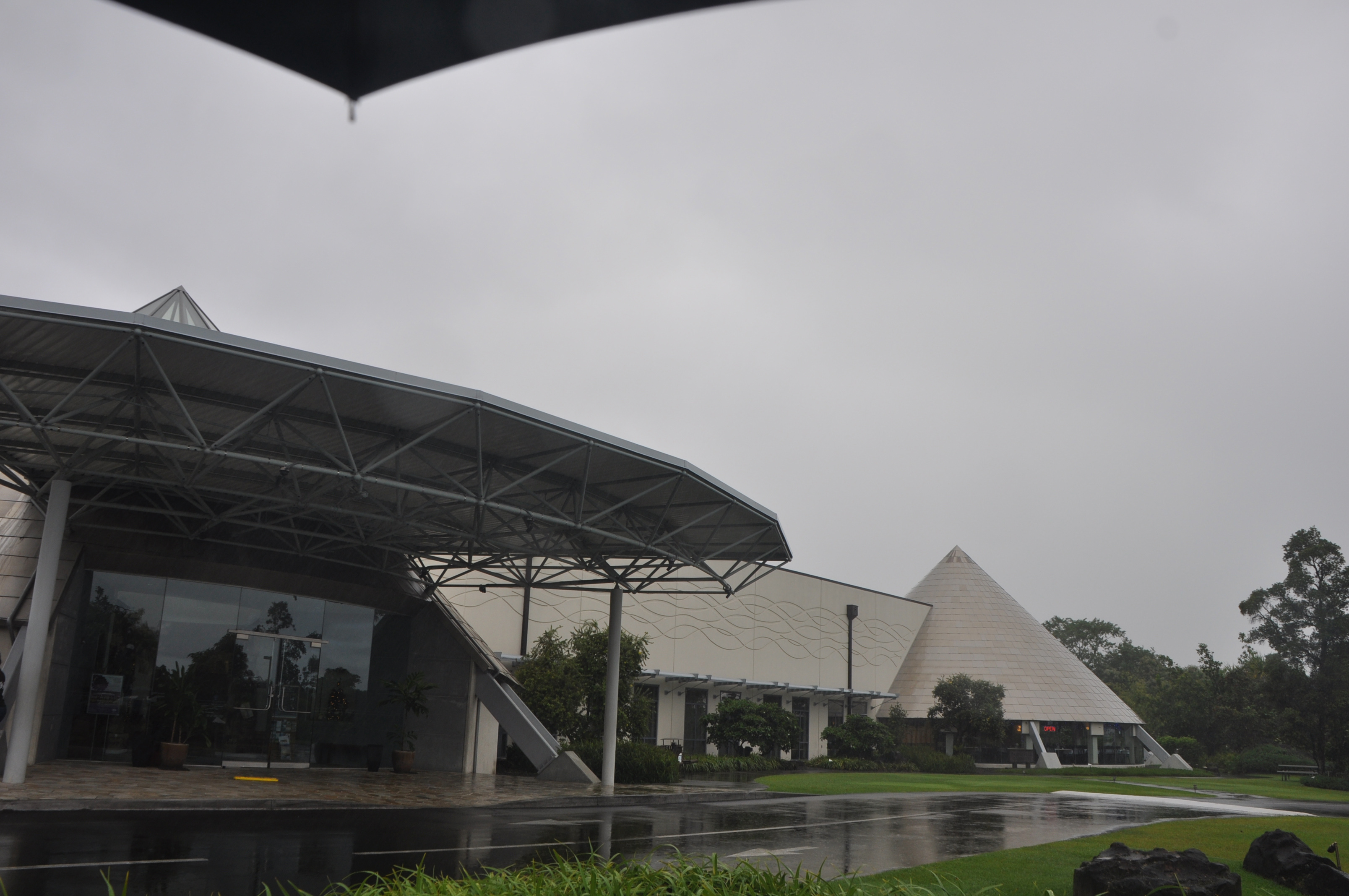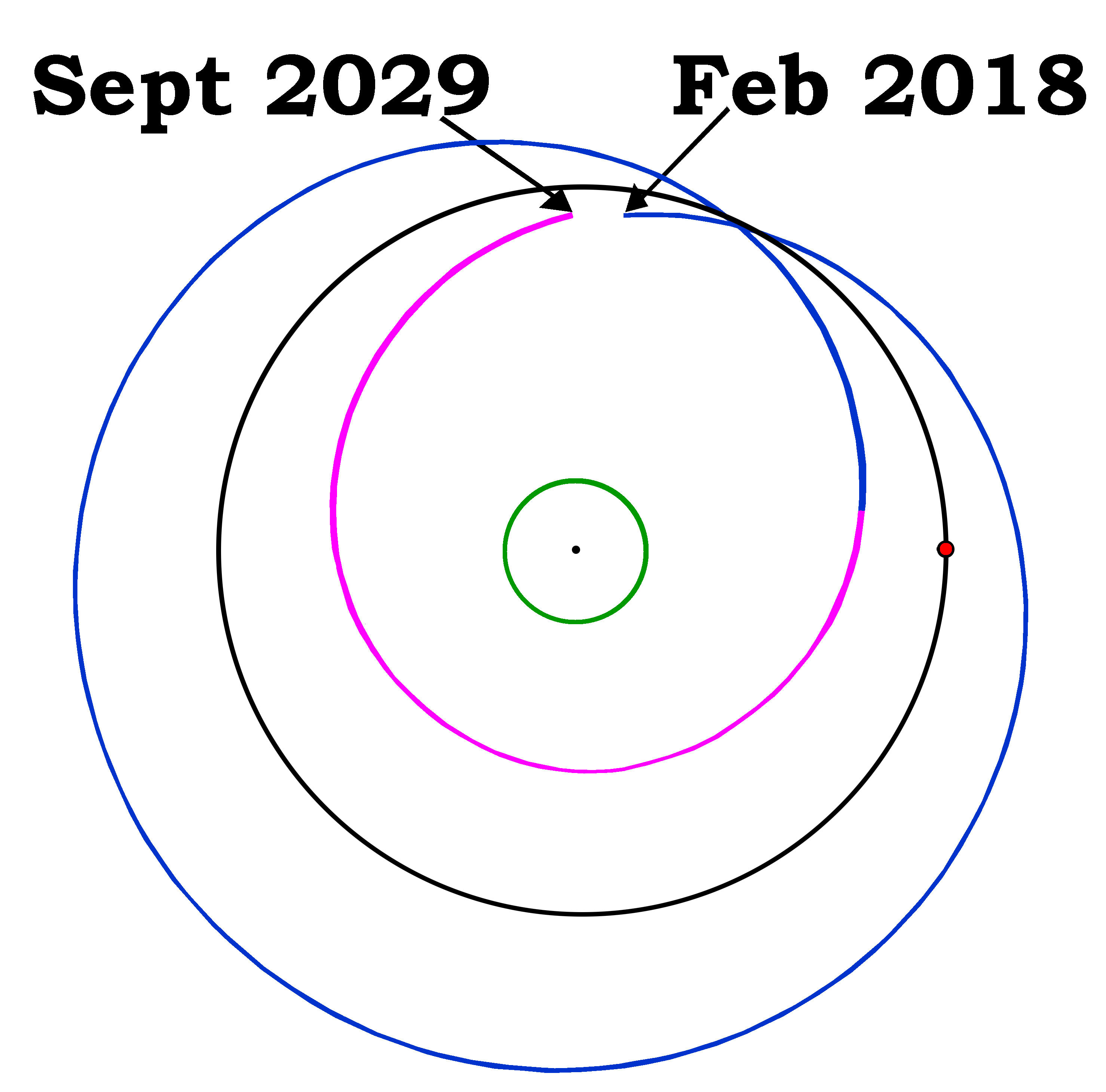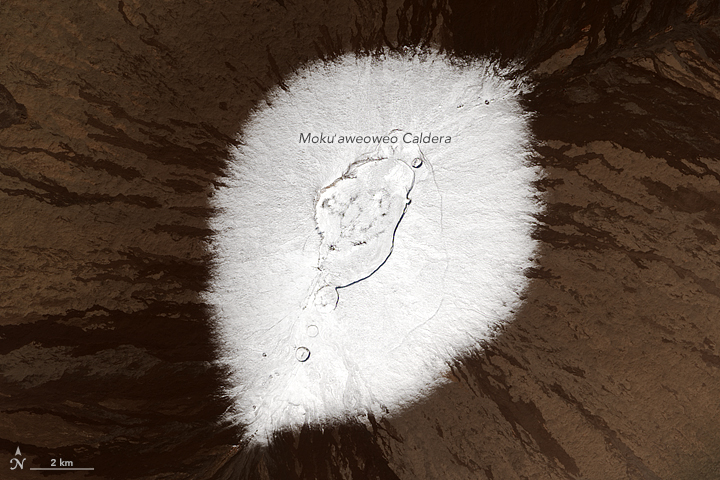|
ʻImiloa Astronomy Center
ʻImiloa Astronomy Center is an astronomy and culture education center located in Hilo, Hawaii. Conceived by founding Director George Jacob in 2001, it features exhibits and shows dealing with Hawaiian culture and history, astronomy (particularly at the Mauna Kea Observatories), and the overlap between the two. ʻImiloa includes a 120-seat planetarium, which features a fulldome video projection system. Planetarium presentations include ʻImiloa's exclusive signature show, "Maunakea: Between Earth and Sky." The bilingual exhibits (in Hawaiian and English) offer two views of Origins and Voyages, presenting the tools, visions and discoveries of the astronomers and the Polynesian voyagers (see Polynesian navigation), the first group of whom are thought to have voyaged to Hawaii from the Marquesas Islands. Visitors to ʻImiloa will leave with a new understanding of the early Polynesians, who used the stars to find these isolated islands in the middle of the vast Pacific Ocean. Ha ... [...More Info...] [...Related Items...] OR: [Wikipedia] [Google] [Baidu] |
Big Bang
The Big Bang event is a physical theory that describes how the universe expanded from an initial state of high density and temperature. Various cosmological models of the Big Bang explain the evolution of the observable universe from the earliest known periods through its subsequent large-scale form. These models offer a comprehensive explanation for a broad range of observed phenomena, including the abundance of light elements, the cosmic microwave background (CMB) radiation, and large-scale structure. The overall uniformity of the Universe, known as the flatness problem, is explained through cosmic inflation: a sudden and very rapid expansion of space during the earliest moments. However, physics currently lacks a widely accepted theory of quantum gravity that can successfully model the earliest conditions of the Big Bang. Crucially, these models are compatible with the Hubble–Lemaître law—the observation that the farther away a galaxy is, the faster it is mo ... [...More Info...] [...Related Items...] OR: [Wikipedia] [Google] [Baidu] |
514107 Kaʻepaokaʻawela
514107 Kaʻepaokaʻāwela (), provisionally designated and nicknamed Bee-Zed, is a small asteroid, approximately in diameter, in a resonant, co-orbital motion with Jupiter. It is an unusual minor planet in that its orbit is retrograde, which is opposite to the direction of most other bodies in the Solar System. It was discovered on 26 November 2014, by astronomers of the Pan-STARRS survey at Haleakala Observatory on the island of Maui, United States. Kaʻepaokaʻāwela is the first example of an asteroid in a 1:–1 resonance with any of the planets. One study suggests that it was an interstellar asteroid captured 4.5 billion years ago into an orbit around the Sun. Nomenclature The Hawaiian name ''Kaʻepaokaʻāwela'' is composed of ''ka'' 'the', ''ʻepa'' 'tricky' or 'mischievous', referring to its contrary orbit, ''o'' 'of', and ''Kaʻāwela'' 'Jupiter'.ulukau HAWAIIAN ELECTRONIC LIBRARY The name was created by A Hua He Inoa, a Hawaiian-language program dedicated to ... [...More Info...] [...Related Items...] OR: [Wikipedia] [Google] [Baidu] |
Alpha Centauri
Alpha Centauri ( Latinized from α Centauri and often abbreviated Alpha Cen or α Cen) is a triple star system in the constellation of Centaurus. It consists of 3 stars: Alpha Centauri A (officially Rigil Kentaurus), Alpha Centauri B (officially Toliman) and Alpha Centauri C (officially Proxima Centauri). Proxima Centauri is also the closest star to the Sun at 4.2465 light-years (1.3020 pc). Alpha Centauri A and B are Sun-like stars ( Class G and K, respectively), and together they form the binary star system Alpha Centauri AB. To the naked eye, the two main components appear to be a single star with an apparent magnitude of −0.27. It is the brightest star in the constellation and the third-brightest in the night sky, outshone only by Sirius and Canopus. Alpha Centauri A has 1.1 times the mass and 1.5 times the luminosity of the Sun, while Alpha Centauri B is smaller and cooler, at 0.9 times the Sun's mass and less than 0.5 times its luminosity. The p ... [...More Info...] [...Related Items...] OR: [Wikipedia] [Google] [Baidu] |
Ithaca, New York
Ithaca is a city in the Finger Lakes region of New York, United States. Situated on the southern shore of Cayuga Lake, Ithaca is the seat of Tompkins County and the largest community in the Ithaca metropolitan statistical area. It is named after the Greek island of Ithaca. A college town, Ithaca is home to Cornell University and Ithaca College. Nearby is Tompkins Cortland Community College (TC3). These three colleges bring thousands of students to the area, who increase Ithaca's seasonal population during the school year. As of 2020, the city's population was 32,108. History Early history Native Americans lived in this area for thousands of years. When reached by Europeans, this area was controlled by the Cayuga tribe of Indians, one of the Five Nations of the ''Haudenosaunee'' or Iroquois League. Jesuit missionaries from New France (Quebec) are said to have had a mission to convert the Cayuga as early as 1657. Saponi and Tutelo peoples, Siouan-speaking tribe ... [...More Info...] [...Related Items...] OR: [Wikipedia] [Google] [Baidu] |
Sagan Planet Walk
The Sciencenter's Sagan Planet Walk is a walkable scale model of the Solar System, located in Ithaca, New York. The model scales the entire Solar System—both planet size and distances between them—down to one five billionth of its actual size. The exhibition was originally created in 1997 in memory of Ithaca resident and Cornell Professor Carl Sagan. Consisting of eleven obelisks situated along a path through the streets of downtown Ithaca, the original Planet Walk leads from the Sun at Center Ithaca to Pluto at the Ithaca Sciencenter. In 2012, the model was expanded to include a representation of Alpha Centauri, the Sun's closest neighboring star, at the ʻImiloa Astronomy Center at the University of Hawaii. The addition of the Alpha Centauri Obelisk made it the world's largest exhibition, until the Akaa Solar System Scale Model added Proxima Centauri in 2018 at a distance of away from Akaa. In 2014, the inner planets and Sun were removed as part of extensive co ... [...More Info...] [...Related Items...] OR: [Wikipedia] [Google] [Baidu] |
Hawaii Route 2000
Route 200, known locally as Saddle Road, traverses the width of the Island of Hawaii, from downtown Hilo to its junction with Hawaii Route 190 near Waimea. The road was once considered one of the most dangerous paved roads in the state, with many one-lane bridges and areas of marginally maintained pavement. Most of the road has now been repaved, and major parts have new re-alignments to modern standards. The highway is mostly one-lane in each direction, but there are two lanes on the uphill portions. The highway reaches a maximum elevation of and is subject to fog and low visibility. Many rental car companies used to prohibit use of their cars on Saddle Road, but now allow use of the road. The highway experiences heavy use as it provides the shortest driving route from Hilo to Kailua-Kona and access to the slopes of Mauna Loa and the Mauna Kea Observatories. Route description Waiānuenue Avenue The mile marker 0 is posted in Hilo on the traffic signal at the intersection ... [...More Info...] [...Related Items...] OR: [Wikipedia] [Google] [Baidu] |
Hawaiian Language
Hawaiian (', ) is a Polynesian language of the Austronesian language family that takes its name from Hawaii, the largest island in the tropical North Pacific archipelago where it developed. Hawaiian, along with English, is an official language of the US state of Hawaii. King Kamehameha III established the first Hawaiian-language constitution in 1839 and 1840. For various reasons, including territorial legislation establishing English as the official language in schools, the number of native speakers of Hawaiian gradually decreased during the period from the 1830s to the 1950s. Hawaiian was essentially displaced by English on six of seven inhabited islands. In 2001, native speakers of Hawaiian amounted to less than 0.1% of the statewide population. Linguists were unsure if Hawaiian and other endangered languages would survive. Nevertheless, from around 1949 to the present day, there has been a gradual increase in attention to and promotion of the language. Public Hawaiian-lang ... [...More Info...] [...Related Items...] OR: [Wikipedia] [Google] [Baidu] |
Hualālai
Hualālai (pronounced in Hawaiian) is an active volcano on the island of Hawaii in the Hawaiian Islands. It is the westernmost, third-youngest and the third-most active of the five volcanoes that form the island of Hawaii, following Kīlauea and the much larger Mauna Loa. Its peak stands above sea level. Hualālai is estimated to have risen above sea level about 300,000 years ago. Despite maintaining a very low level of activity since its last eruption in 1801, and being unusually inactive for the last 2,000 years, Hualālai is still considered active, and is expected to erupt again some time within the next century. The relative unpreparedness of the residents in the area caused by the lull in activity would worsen the consequences of such an event. The area near the volcano has been inhabited for centuries by Hawaiian natives, dating back to before recorded history. The coast west of Hualālai in particular had several royal complexes. The volcano is also important ec ... [...More Info...] [...Related Items...] OR: [Wikipedia] [Google] [Baidu] |
Mauna Loa
Mauna Loa ( or ; Hawaiian: ; en, Long Mountain) is one of five volcanoes that form the Island of Hawaii in the U.S. state of Hawaii in the Pacific Ocean. The largest subaerial volcano (as opposed to subaqueous volcanoes) in both mass and volume, Mauna Loa has historically been considered the largest volcano on Earth, dwarfed only by Tamu Massif. It is an active shield volcano with relatively gentle slopes, with a volume estimated at , although its peak is about lower than that of its neighbor, Mauna Kea. Lava eruptions from Mauna Loa are silica-poor and very fluid, and tend to be non-explosive. Mauna Loa has probably been erupting for at least 700,000 years, and may have emerged above sea level about 400,000 years ago. The oldest-known dated rocks are not older than 200,000 years. The volcano's magma comes from the Hawaii hotspot, which has been responsible for the creation of the Hawaiian island chain over tens of millions of years. The slow drift of ... [...More Info...] [...Related Items...] OR: [Wikipedia] [Google] [Baidu] |
Mauna Kea
Mauna Kea ( or ; ; abbreviation for ''Mauna a Wākea''); is a dormant volcano on the island of Hawaii. Its peak is above sea level, making it the highest point in the state of Hawaii and second-highest peak of an island on Earth. The peak is about higher than Mauna Loa, its more massive neighbor. Mauna Kea is unusually topographically prominent for its height: its wet prominence is fifteenth in the world among mountains, at ; its dry prominence of is second in the world, only after Mount Everest This dry prominence is greater than Mount Everest's height above sea level of , and some authorities have labelled Mauna Kea the tallest mountain in the world, from its underwater base. It is about one million years old and thus passed the most active shield stage of life hundreds of thousands of years ago. In its current post-shield state, its lava is more viscous, resulting in a steeper profile. Late volcanism has also given it a much rougher appearance than its neighbori ... [...More Info...] [...Related Items...] OR: [Wikipedia] [Google] [Baidu] |
Mauna Kea Observatory
The Mauna Kea Observatories (MKO) are a group of independent astronomical research facilities and large telescope observatories that are located at the summit of Mauna Kea on the Big Island of Hawaiʻi, United States. The facilities are located in a 525-acre (212 ha) special land use zone known as the "Astronomy Precinct", which is located within the 11,228-acre (4,544 ha) Mauna Kea Science Reserve. The Astronomy Precinct was established in 1967 and is located on land protected by the Historical Preservation Act for its significance to Hawaiian culture. The presence and continued construction of telescopes is highly controversial due to Mauna Kea's centrality in native Hawaiian religion and culture, as well as for a variety of environmental reasons. The location is near ideal because of its dark skies from lack of light pollution, good astronomical seeing, low humidity, high elevation of , position above most of the water vapor in the atmosphere, clean air, good we ... [...More Info...] [...Related Items...] OR: [Wikipedia] [Google] [Baidu] |



.jpg)





